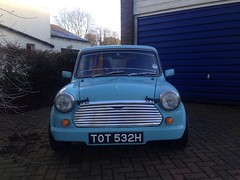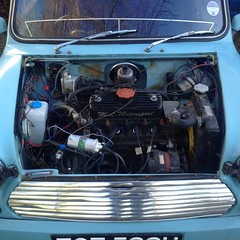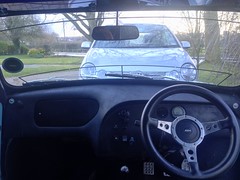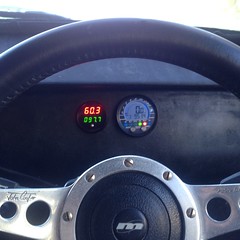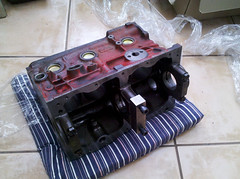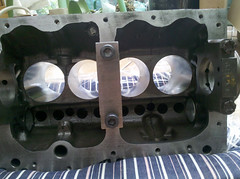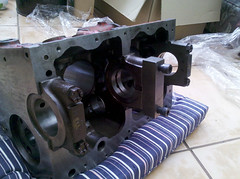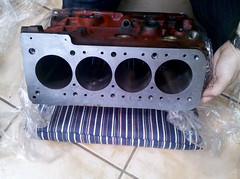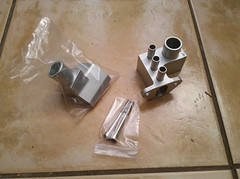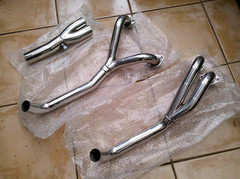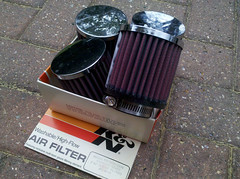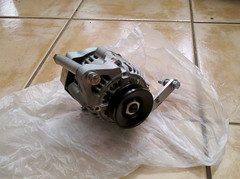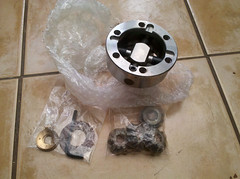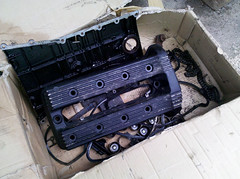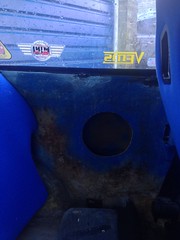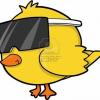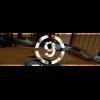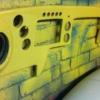The car has now been sold - the engine parts will be re-posted in the Engines Sale section soon
After several years of happy ownership, it's time to let the Domino go. Life changes - and a car with only two useable seats and practically no boot space (read later for details) just isn't practical for me anymore.
What is a Domino? You can read the wikipedia page for a little information, but basically, they were a brand of fibreglass mini-based kit cars, now out of production. The HT (hard top) had, unsurprisingly, a hard top. If you want to know more, keep reading ;)
BUT this isn't just the car I'm selling: I'm also including all the parts for the TwinCam BMW-headed engine project that was going to go into it. 90% of the components are here, it only needs a few specialist parts (head gasket, a few bolts) and a gearbox (although, at a push, you could use the gearbox from the current engine).
What you're therefore getting for your money is a fully road-legal, tax-free, drive-away car PLUS 90% of a new fuel injected engine for you to do with as you please.
First, a rundown of the car:
Tax-free and MOT'd until January 7th 2015, it's a fibreglass Domino HT shell with 100% fibreglass doors, fibreglass double skin MK1 bootlid & fibreglass single-skin bonnet, painted in classic 'Marina Blue' colour.
 photo.JPG 69.96K
133 downloads
photo.JPG 69.96K
133 downloads  photo.JPG 67.87K
95 downloads
photo.JPG 67.87K
95 downloads
The Domino HT is the hard-top saloon of the Domino range. It's about the same size as a standard mini, the engine bay is a little longer. It's obviously seamless, the rear lights are positioned higher than standard and it has a bodykit-style bulge around the bottom. Everything here is fibreglass: the body, the bonnet (single skin), bootlid (double skinned) and doors. The doors are a little special; usually a Domino's doors are half metal (from the donor car) and half fibreglass. I detached the rusted metal parts and, modifying a pair of regular mini fibreglass doors, made a pair of Domino doors that were 100% fibreglass (my original thread might still be around on the forum somewhere).
The Domino is correctly registered on the v5 as a DOMINO HT, registration date 1969. This is a pretty important (and valuable) point to make - many kit cars out there aren't registered properly with the DVLA, which can cause problems with MOT tests and other legal issues. And of course, by being a 1969 reg, this qualifies it as a historic vehicle and is therefore exempt from road tax.
Driver, passenger and both quarterlight windows are polycarbonate, while the front is a Monte-Carlo style heated window (hugely useful).
1293 engine + stage 3 head, K&N cone filter, manifold exhaust. The engine was built by ML Motorsports in 2009 and the majority of its MOTs/maintenance has been done by Andy since. It's done very few miles since the build - around 1000 miles only. This is another reason I'm passing the Domino on - it's been criminally underused.
Other notable mentions include:
Lightened Minispares flywheel,
Super cool minispares radiator,
Quickrack steering rack,
Minisport 7.9" 4 pot brakes,
Heated front windscreen (already mentioned, but i thought I'd mention it again, a real godsend in the winter)
MED machined engine management crank pulley + modified Specialist Components sensor/pickup
Ignition is electronically controlled by a Ford coilpack driven by a VEMS ECU (please note, this isn't simply a Megajolt. The ECU was purchased and fitted to control a full fuel injection system - the intention was to use it with the Twincam engine project).
For more information on VEMS, the VEMS forum can be found here. It's a great little piece of equipment with tons of functions and features, all setup through it's own VEMStune software that gets installed on a laptop that you hook up to it (I'll give you the ancient laptop I've been using for this if you need it).
The VEMStune software can update itself online, and once you get the hang of understanding what it's capable of, is quite easy to use. Please note though, if you've never looked into setting up an electronic ignition system (let alone a fuel injected setup) you'll probably find everything pretty daunting to begin with.
In the boot, we have a custom aluminium fuel tank that fits the all-in-one fuel pump/filter/sensor from a Toyota MR2. Until the injection system is set up, I'm not using the pump itself. Currently, a standard fuel pump pulls fuel from the bottom of the tank and the top pipe is a breather - but the tank has been designed so that, once the injection pump is being used, the bottom fuel pipe and top can be connected together with a piece of clear pipe to give a visual idea of the fuel level.
There's a fibreglass dash with a VEMS gauge, configurable to display various data from the ECU (currently it can display RPM, temperature and manifold pressure - once the ECU is running the full injection setup, it'll be able to display a whole lot more). And there's an Acewell speedometer driven by a sensor on the rear hub - although it needs a bit of re-calibration.
Behind the dash is a whole rat's nest of wiring - there are a lot of wires connected to the ECU that currently go nowhere; eventually they'll go to the various sensors and injectors. Currently, the only thing that the ECU controls is the coilpack for electronic ignition (no EDIS required, the ECU handles everything).
There are two Cobra Monaco bucket seats (although you can have a pair of standard mini seats too if you want) fitted to sliding seat frames - not that there's any space inside to enable them to slide. I have had passengers in the back but they need to be pretty agile!
So... there are a lot of good quality parts in the car: it runs very nicely and the electronic ignition system means the timing is rock-solid.
(I'll get more pictures up as soon as possible!)
And now onto the TwinCam BMW engine components!
If you're new to the BMW hybrid engine idea, the basic idea is to bolt a BMW K series motorcycle cylinder head onto a mini block to create a fuel-injected, twin-cam hybrid engine.
The head you'll be getting is the K100 8 valve type - once complete, Specialist Components' estimates are that it should produce around 110bhp - a figure that your standard helicoil mini gearbox should (just about) be able to cope with & considering the weight of the body, will probably cause the car to take-off!
The parts you'll get are:
BMW K100 8 Valve Twin Cam cylinder head, cleaned and machined for the A-Series block by Specialist Components
K100 fuel rail (shown attached to the head)
A+ 1303 (1275 +.30) block, machined to fit the above cylinder head by Specialist Components,
1275 +.30 Hypatec pistons, 8V cutouts machined by Specialist Components, fitted with standard rods
Specialist Components (v2) conversion kit,
Specialist Components Ancilliaries kit,
Specialist Components stainless steel exhaust,
Specialist Components camshaft,
K1100 Throttle Bodies + modified TPS (as recommended in Specialist Components' build guide),
4 x brand new K&N filters ready to fit the throttle bodies,
Compact alternator kit (again, from Specialist Components)
X pin diff from MiniSpares,
A standard A-Series crank,
And a front mounted radiator from a MPi that you might want to use.
Spares, plus extras: 4 x K100 fuel injectors (untested), various sensors (including a new wideband lamba sensor for the exhaust) and multiple bundles of spare wire.
So it's basically almost all the parts you need (minus gearbox) to put together a Specialist Components Twincam engine. As the ECU is already fitted and running in the Domino, you only need to build the engine, finish the wiring and connect everything up!
None of the Twincam parts have ever been used, all are literally in 'as new' condition. I also have receipts for them all and for the work that Specialist Components have done.
I'll also include the Specialist Components build guide and as much advice as I can give you regarding the wiring job I've done to accommodate the BMW kit. Basically, I've created a separate 12v feed for all of the injection system electronics that runs through a switch in the dashboard.
The standard mini parts (lights, heated windscreen) run through the ignition switch as per usual. There's a new 16 x blade fuse box for all the fuses. I'll make you a guide to the custom wiring; I have trouble remembering where some wires go.
Other things I'll throw in:
A fairly ancient laptop that I use to run the VEMStune tuning software (don't expect to use it for anything else - the only reason I haven't replaced it is because it has a useful serial port on it)
A White roof rack (+ rubber feet + gutter clamps) - completely unusable on a car with no gutters, was intending on modifying it but never got round to it.
So bad points:
The car isn't perfect. Frankly, if I had the time, I'd take it apart and rebuild it again. If you're going to build the Twin-Cam engine, it might be a good opportunity to work on the car too. Points that could do with some attention are:
The drivers's side polycarbonate window has become pretty scratched. It could be polished out by someone who knows what they're doing: I generally just open the window instead.
The doors - they close and lock, but the fit isn't great - when it rains, water finds a way inside.
The headlining has fallen away from the tops of the quarter light windows - because it was fitted after they were. You might want to remove the quarter light windows and re-do the headlining.
The interior at the back hasn't been finished (shown about with the passenger seat removed) - previous owner cut holes for speakers (I think) that need covering up.
I'm finished!
So, drop me a line if you have any questions or would like to see the car in person - the car is currently in Meopham, Kent (DA13 postcode). I'll be taking more photos of the interior ASAP.
I'm looking for around £4000 or offers around that figure.
Edited by atom, 08 February 2014 - 09:15 AM.


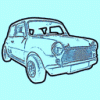
 This topic is locked
This topic is locked
